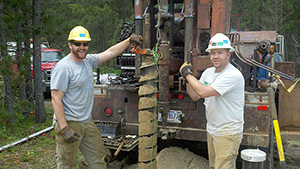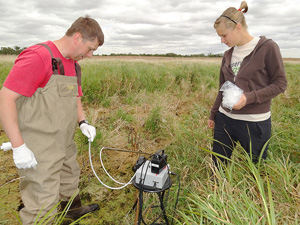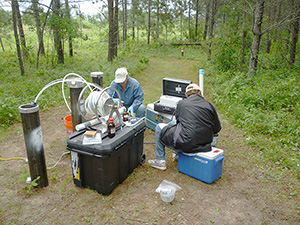
Minnesota Water Science Center Newsletter
Spring 2012
U.S. Geological Survey
Minnesota Water Science Center
2280 Woodale Drive
Mounds View, MN 55112
http://mn.water.usgs.gov
Terrestrial crude oil spills: Decades of science from the Bemidji, Minnesota Research Site
 |
The symposium will be held at the University of St. Thomas, St. Paul campus. The symposium will be followed by a site tour on June 12, starting at 1:00 p.m. Anyone may attend the symposium and site tour. The registration website for the symposium and site tour is available at: http://mngts.org/petroleum_remediation/. The symposium brochure also may be downloaded from the website.
The research objectives for the site are organized into four components: unsaturated-zone, saturated-zone, coupled unsaturated zone and saturated zone, and plume-scale research. In addition, the site provides a unique opportunity for researchers to develop and apply new methods for investigating sites of light non-aqueous phase liquid (LNAPL) contamination.
Research at the site currently is governed by a four-party collaborative agreement signed in early 2009 by Enbridge Energy Limited Partnership, the Minnesota Pollution Control Agency, Beltrami County, and the USGS Minnesota Water Science Center. The purpose of the collaborative agreement is to support the advancement of science, research, and education on the fate, transport, and natural attenuation of crude oil contamination in the subsurface at the site, including providing some research funding through a Request for Proposals (RFP) process. The following three projects were funded through the 2012 RFP process. The projects were awarded a total of approximately $20,000 and brought with them approximately $36,000 in matching funds and in-kind contributions.
Field studies of physical and biogeochemical controls on fate and transport of hydrocarbons (BTEX and ethanol) in subsurface systems.
Jennifer T. McGuire, University of St. Thomas; Isabelle M. Cozzarelli, USGS, Reston, VA.
Biogeophysics: confirming the geobattery origins of the self potential signals observed at the National Crude Oil Spill Fate and Natural Attenuation Research Site.
Lee Slater, Rutgers University-Newark, NJ; Estella Atekwana, Oklahoma State University, Stillwater, OK; André Revil, Colorado School of Mines, Golden, CO; Dimitrios Ntarlagiannis, Rutgers University-Newark, NJ; John W. Lane, Jr., USGS, Office of Groundwater, Branch of Geophysics, Storrs, CT.
Distribution of vegetation within the spray zone at the National Crude Oil Spill Fate and Natural Attenuation Research Site.
John L. Nieber, University of Minnesota.The dates for the 2012 field season are June 12 - June 22. The site tour on June 12 will kick off the 2012 field season. Additional information regarding previous work, publications, and ongoing work at the Bemidji site is available on the project web site.
Contact: Mindy Erickson - Site Manager
Mercury in stream ecosystems
Mercury is a well-known resource impairment in Minnesota, and the USGS has collaborated on several mercury studies in Minnesota. The USGS Minnesota Water Science Center also is involved in coordinating national-scale assessments of mercury in stream ecosystems. Detailed, interdisciplinary studies have examined mercury cycling and bioaccumulation in streams in Oregon, Wisconsin, Florida, New York, and South Carolina. A recent paper from this study highlights the influence of landscape geomorphic features on mercury and methylmercury in stream water. Multivariate models that included hydrogeomorphic, riparian-area, and open-water metrics explained substantially more variation in methylmercury concentrations than wetland abundance alone-a metric commonly related to methylmercury in natural waters-could explain. The approach described holds promise for identifying waters with expected high mercury concentrations in glaciated riverine ecosystems. In addition to the detailed studies, the USGS has published reports on a national survey of mercury in streams, and an analysis of mercury trends in fish. To date, the USGS National Water-Quality Assessment Program's Mercury in Stream Ecosystems team has published 21 interpretive reports and journal papers, and 11 data and methods reports, available for download at: http://water.usgs.gov/nawqa/mercury/pubs/.Contact: Mark Brigham
USGS Environmental Effects of Agricultural Practices (EEAP) Team
 |
Contact: Victoria Christensen
National Water-Quality Assessment Program Enters Decade Three
Federal fiscal year 2013 will be the first year of the third decade (Cycle 3) of monitoring and assessment activities for the National Water-Quality Assessment (NAWQA) Program. NAWQA staff are working on an implementation plan that includes a discussion of program objectives, approaches, products and outcomes, resource requirements, budgets, timelines, and the staffing. The plan assumes level appropriations of $66.5 million throughout FY13-FY22 and inflation of 4 percent per year. The draft plan represents a starting point for preparing NAWQA's annual work plan guidance. Although considerable work and analysis has been done to develop the plan, it has not been finalized. However, the following areas of focus are identified:- Joint NAWQA-U.S. Environmental Protection Agency study of water quality and ecology in streams in the Upper Midwest
- Integrated watershed studies
- National fixed site network for monitoring streams and rivers
- Groundwater monitoring and modeling studies
- Studies of the effects of stressors on stream ecology
Upcoming Groundwater Conference
 |
This year's conference title and theme is "Groundwater Opportunities and Conflicts in the 21st Century: Economy to Ecology." This year's event is sponsored by the Minnesota Ground Water Association, which is celebrating its 30th anniversary.
USGS scientists are actively involved in planning the conference, in part by co-chairing two of the topical sessions. Perry Jones and Don Rosenberry will co-chair the "Groundwater/Surface-Water Interactions" session, and Mindy Erickson will co-chair the "Water Quality" session. USGS also will provide financial support for the event by having an information booth in the Exhibitor hall.
Two key conference deadlines are: July 16 - Deadline for submittals of Paper/Poster, author, title, and abstract; and September 7 - pre-registration (cheaper registration) deadline. Visit the conference website for complete conference information or to submit an abstract: http://www.mwgwc.org/.
